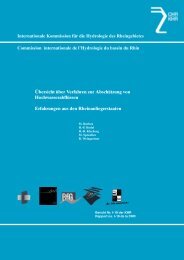ABSTRACTS 'Extreme Discharges' - CHR-KHR
ABSTRACTS 'Extreme Discharges' - CHR-KHR
ABSTRACTS 'Extreme Discharges' - CHR-KHR
Create successful ePaper yourself
Turn your PDF publications into a flip-book with our unique Google optimized e-Paper software.
Based on these indicators and diagnostic maps we identify the process types of 11518 maximum annual flood<br />
peaks in 490 Austrian catchments. Results indicated that 43% of the flood peaks are long-rain floods, only 3%<br />
are snow-melt floods and the relative contribution of the types changes with the flood magnitude (Table 2). It<br />
should be noted that these process interpretations are applicable to the scale of the gauged catchments examined<br />
with a median of about 150 km². In smaller catchments flash floods, for example, may be more important than<br />
these statistics indicate.<br />
There are pronounced spatial patterns in the frequency of flood type occurrence. In catchments at the northern<br />
fringe of the high Alps, long-rain floods are particularly common. The high Alps tend to act as a topographic<br />
barrier to north-westerly airflows, and orographic enhancement often produces persistent rainfall which can<br />
result in floods. The regions of the highest relative importance of long-rain floods are identical with the regions<br />
of the highest mean annual rainfall in Austria. Short-rain floods occur more frequently in southern Austria than<br />
north of the Alps. This is likely due to two mechanisms. The main ridge of the Alps tends to block weather systems<br />
approaching from the northwest which reduces the advection of moist air and hence the persistence of the<br />
rainfall. Also, south of the Alps southern airflows may produce floods that are associated with high-intensity<br />
short-duration storms. Flash-floods occur significantly less frequently than long-rain and short-rain floods.<br />
Flash-floods are mainly important in eastern Austria, specifically in the hilly region of Styria and the southern<br />
Burgenland. The hilly terrain appears to increase the instability of the boundary layer and hence the likelihood<br />
of convective storms. Rain-on-snow floods are important in the catchments of medium altitude in the north of<br />
Austria. A rapid increase in air temperature in early winter or spring appears to occur quite frequently as a result<br />
of the inflow of warm and moist air. Relatively low rainfall depths on an existing snow cover appear to produce<br />
a significant portion of maximum annual floods in these catchments. Snow-melt floods are occur only in the<br />
high Alps where both snow and glacier melt can be important and snow-melt floods rarely produce the maximum<br />
annual flood.<br />
REFERENCES<br />
Merz, R. & Blöschl, G. (2003) A process typology of regional floods. Water Resources Research, VOL. 39,<br />
NO. 12, 1340, doi:10.1029/2002WR001952<br />
27





